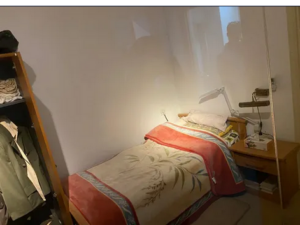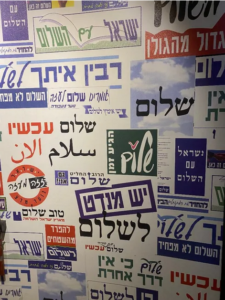From Yad Vashem to Arafat’s office: A Palestinian and a Jew tour Israeli and Palestinian museums together

Omar Dajani, at Yad Vashem in Jerusalem
Omar Dajani and Mira Sucharov writes in Haaretz on 24 April 2023:
What happens when a Palestinian and a Jew visit Israeli and Palestinian museums together? Over the last year, on successive trips including to Tel Aviv, Jerusalem and Ramallah, we decided to find out.
What follows is a correspondence between us.
Omar: Of all the museums we visited, the one that left the biggest impression on me was ANU: Museum of the Jewish People. Going in, I understood that I’m not part of the “we” to which the museum’s Hebrew name refers, and it quickly became clear that it was conceived as a museum not just of but for the Jewish people.
At the entrance, screens display videos of Jewish people telling their stories, life-size and at eye level. We see Jews of different races, dressed in different ways and speaking different languages; we see gay and straight Jews, religious Jews and Jews with tattoos. I imagined what I would feel encountering this gallery if I were Jewish. I think I would feel seen, included, embraced.
It reminded me of the video that U.S. Customs used to play at international arrivals during the Obama era. It featured Americans of every stripe smiling and saying “Welcome!” against the backdrop of spectacular American scenery. That video not only reflected a different style – glossy and toothy in an American way – it also articulated a different concept of peoplehood, one that could include me. At ANU, I wasn’t seeking to be welcomed as one of the fold, but as the son of a Palestinian refugee, I was mindful of the consequences of exclusion.
As we made our way through the exhibits, I was touched by the pleasure you showed in seeing artifacts of Jewish culture, like the collection of Hanukkah dreidels and Purim noisemakers whose function you were excited to explain to me. It occurred to me that, more than grand ideas, it’s little things that give us a feeling of connection.
When we arrived at the displays on Jewish genius in all areas of human achievement, I couldn’t help but be dazzled: Einstein! Kafka! Winehouse! Maybe I felt a little envious, too – as if I were being reminded, again, of the accomplishments of a brilliant cousin. But I chastened myself for thinking petty thoughts, imagining what these displays might mean to someone who had grown up marginalized or persecuted for being Jewish to discover so much to feel proud of.

The bed from Yasser Arafat’s Ramallah bunker at the Yasser Arafat Museum
That said, when we went down to the museum’s second floor, we encountered what felt to me like its main failing. The exhibits there describe how Jews lived through the centuries as a minority – at times accommodated but more often persecuted – while celebrating Israel’s founding as a new opportunity for Jewish communal life. It struck me as ironic that a museum that dwells on how Jews persevered as “the other” does nothing to explore how Jews have treated the other since acquiring sovereignty in Israel-Palestine.
Examining that chapter seems crucial for a museum built on the confiscated lands of Al-Shaykh Muwannis, a Palestinian village that was forcibly depopulated in 1948 because its residents weren’t Jewish. It also raises other important questions: Is the imperative of achieving sovereignty the only lesson that can be drawn from Jews’ experience of otherness? Or does it equally point to the dangers of ethnocentricism inherent in the nation-state itself? At a time when a party that calls itself “Jewish Power” – Otzma Yehudit – is in the Knesset, these questions seem urgent.
Mira: This may be the first time that my ethical compass has clashed with my heart. On the one hand, I’m grateful that you’ve identified these gaps at ANU. Still, your critique stings. As we were planning our fieldwork, we talked about introducing each other to the people and places most meaningful to us. And in so doing, we wondered, should we each adopt the mode of gracious host and appreciative guest?
I suppose that’s the stance I adopted as we toured ANU: seeking to bring you into “my” space. But I now realize that even saying that about a museum in Tel Aviv – unlike the Contemporary Jewish Museum, which we visited together in San Francisco – underscores this very problem: that you, a Palestinian, are now forced to be a guest in your own country.
Even so, you asked what moved me. I was tickled by an exhibit on the “JAP” – the “Jewish American princess” – including an incisive panel pointing out the “grotesqueness” of the trope. I’ve long known that it was both misogynistic and antisemitic, but it nevertheless animated a lot of the jokes among my friends and me as I was growing up.
So yes, I guess that some of the alienation you experienced drew from the same well that gave me a sense of at-homeness. Still, having you there, especially as I was able to interpret for you many everyday Jewish objects that I might otherwise have breezed past, deeply enhanced the experience for me. Whether that’s positive or problematic given what you’ve shared above, I’m not entirely sure.
Omar: I think it’s definitely positive, especially since, during our visits together to Israel-Palestine, we’ve been trying to help each other see things we might not see on our own. So I guess it’s only fair for me to ask you whether you were disturbed by anything we saw in Palestinian museums.
Mira: I must say that I was incensed by a single panel in what was otherwise an impressive treatment of Israeli-Palestinian history at the Yasser Arafat Museum in Ramallah. Here the curators whitewashed the 1972 Munich massacre, where, as we both know, Palestinian militants murdered 11 Israeli Olympic athletes in cold blood. After describing the hostage taking, the text stated, “German and Israeli security forces attempt[ed] a rescue, resulting in the deaths of all the hijackers and nine Israeli athletes.”
Aside from that, what I found most compelling was the chance to visit the Arafat Museum with you. Arafat’s office, which is preserved for visitors to see alongside the modest living quarters where he was imprisoned by Israeli forces until his death, took on a different light viewing it with someone who had spent time there, as an international official, during that last phase of Arafat’s life.
Omar: I completely accept your point about the presentation of the Munich Olympics massacre at the museum. As we discussed it at the time, I similarly took exception to the way some of the history was presented at the Yitzhak Rabin Museum.

Pro-peace stickers at the Yitzhak Rabin Museum in Tel Aviv.
For example, one panel there states in passing that “Christian troops” carried out the Sabra and Shatila massacres in 1982 without mentioning that the Israeli army had surrounded the camps, blocked residents from fleeing and supplied flares to illuminate the killing spree. It may be that pronouncing historical truth with moral clarity is more than we should expect from national museums, but I think a lot could be learned from having Palestinians and Jews visit these places together.
I also wished the Arafat Museum had done more to present Palestinian life before the 20th century and the Nakba. Despite the common misconception that Palestinian identity was forged by its encounter with Zionism, we have a rich history extending back centuries that needs telling. The Palestinian Museum in Bir Zeit, which unfortunately we weren’t able to visit together, makes an important contribution to filling that gap with its current exhibition, “A People By the Sea: Narratives of the Palestinian Coast.”
On a similar note, one of the things that struck me most powerfully at Yad Vashem was that it begins with stories, images and sounds from Jewish communities in Europe before the Holocaust. Having a glimpse of the richness and rootedness of Jewish life in Europe makes contemplating what followed all the more devastating.
Mira: As we were planning our Jerusalem itinerary, I recall that it was you who pressed us to fit in Yad Vashem. But it was my emotional reaction that surprised me the most. After an hour of making our way through the exhibits – it was many years since I’d been there and I was stunned by the aesthetic, emotional and intellectual power of the redesigned version – I wandered ahead. And then, as I approached the Hall of Names, I suddenly broke down.
There was something about the idea of dying anonymously, and of survivors, their descendants and others striving to ensure that the nameless are named through painstaking recordkeeping that shattered me. Perhaps the nature of my own psychology makes me particularly attuned to the idea of recognition. Or perhaps it’s that my late father-in-law, as a Hungarian-Jewish teenager, endured a year in the hell of Auschwitz. By the time you arrived in the hall, I was sitting on the floor, my arms perched limply on my knees. Moments earlier, I had been heaving with sobs, steadying myself on a railing, half trying to become invisible and half wanting the strangers around me to take me in their arms.
Omar: I feel like that’s the only human reaction one could have to what we saw.

Mira Sucharov at the site of the 1948 Deir Yassin massacre, now on the edge of a Jerusalem neighborhood
Mira: Indeed. Once I recovered, we went to the site of Deir Yassin, where in April 1948 Irgun and Lehi forces massacred over 100 Palestinians, many of them women and children. We circled the village, whose site, now nestled in Jerusalem’s Har Nof neighborhood, serves as a psychiatric facility. We knew there would be no visible sign of commemoration, but we wanted to see for ourselves.
Much of our ambivalence and misgivings could be addressed if Israel had a museum properly reckoning with the Nakba while also envisioning what a future dedicated to justice and equality might look like – and if such a museum were built in the spirit of Palestinians and Jewish Israelis telling their stories directly to each other. Maybe in time for Israel’s 76th?
Omar Dajani served as a legal adviser to the Palestinian negotiating team in peace talks with Israel from 1999 to 2001. He is currently professor of law at McGeorge School of Law, University of the Pacific. Mira Sucharov is professor of political science at Carleton University. Together, Omar and Mira are developing a podcast on the past, present and future of Palestinian and Jewish life in Jaffa, and are writing a book on diaspora attachment to Israel-Palestine.
This article is reproduced in its entirety
